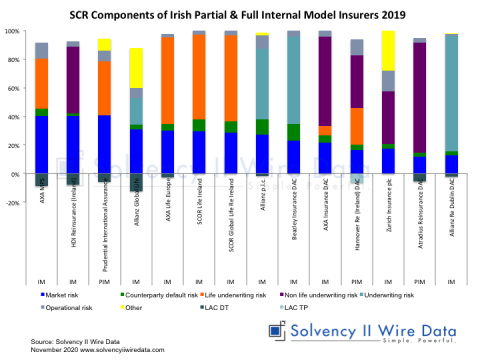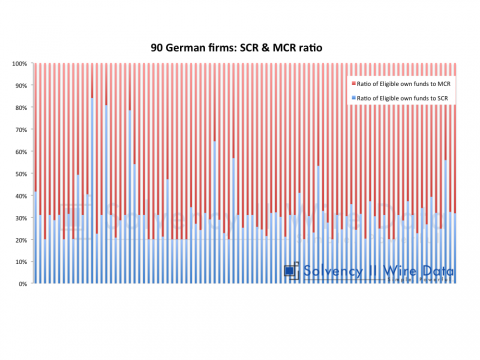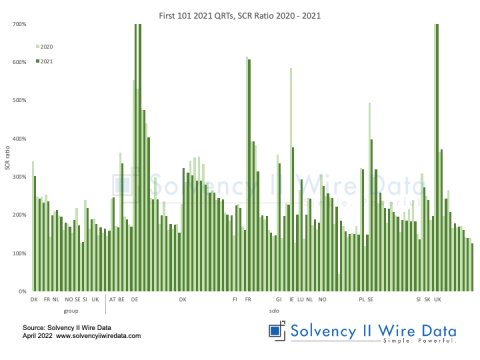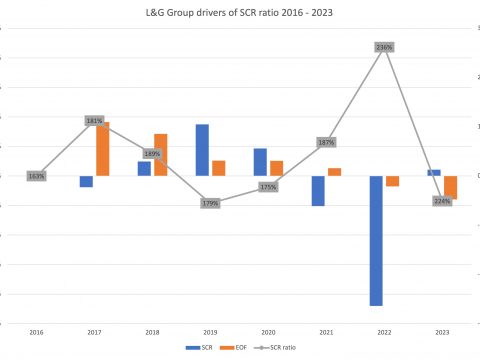SFCR Text Analysis
Solvency II Wire has obtained four SFCR reports and conducted text analysis of their content to begin to shed light on the kind of information and depth of disclosure. The SFCR is particularly problematic because it leaves most of the disclosure choices with the firm. The structure and headings of the report are stipulated in the regulation (Commission Delegated Regulation (EU) 2015/35), but it is up to the individual firm to decide how to populate each section. In addition, firms must consider the wide range of audiences for the report.
Not only must the text be accessible to both sophisticated market participants and policyholders, but for many insurers, it will be the first time that competitors will get such an up close and personal look into their affairs.

About the analysis
In additional to a general reflection on the entire report, illustrative examples are used from the following parts: Introduction/executive summary; B.1 General information on the system of governance; D1. Assets; and the ‘Any other information’ section in the five parts of the report.
The purpose of this selective analysis is to begin to shed light on what, how and how much information firms are disclosing publicly. It is not meant as a commentary on the performance of individual firms.
The firms
- Evolution Insurance Company Limited, a Gibraltar regulated insurance company, which underwrites surety bonds, building warranty, title insurance, motor insurance, motor insurance ancillary products, and also fronts insurance into other EEA jurisdictions. The firm is the solo entity of Evolution Holdings (Guernsey) Limited (‘EHGL’). – Assets £108,196 Liabilities £89,596* *(All figures are based on Solvency II valuation, figures are 000’s)
- Hansard Europe DAC, an Ireland regulated unit-linked life assurance private company limited by shares. The company is in run-off. – Assets £199,263 Liabilities £186,989
- Vitality Life Limited, a UK regulated life insurance entity authorised to carry out long term insurance business. Its ultimate parent is Discovery Limited based in South Africa. – Assets £47,868 Liabilities £53,258
- The Wren Insurance Association Ltd, a UK regulated mutual insurance association providing professional indemnity (PI) cover for architects. – Assets £77,757 Liabilities £32,291
Statistics and readability of the SFCRs
Much like the ORSA reports, firms have been trying to work out how long the SFCR report should be. The four reports analysed have an average length of 37 pages (excluding the QRT annexes) ranging from 24 pages (Wren) to 51 pages (Vitality life).
To gauge the accessibility of the report a SMOG Readability Formula test, which estimates the number of years of education needed to understand the text was applied to the full narrative text of each report. The scores are as follows: Vitality Life 12.4, Wren 12.6, Evolution 13.5 and Hansard 14.6. By way of reference the SMOG index for this article is 14.5.
Introduction / Executive summary

Each report must contain a “clear and concise” summary or introduction, which according to Article 292 of the Regulation, “shall be understandable to policy holders and beneficiaries”. The summary should also highlight any material changes relating to the five parts of the report.
Both the Hansard and Evolution reports provided a one page summary, while the Wren and Vitality Life text runs to 3 and 7 pages respectively. The SMOG index ranges between 13.3 – 15.8. Among them, the executive summaries of the four reports contain some information about the purpose of the report, explaining that it is a new requirement of the Solvency II Directive, and they all give a short description of the company structure and its lines of business.
Some also provided an outline of future planning and projections for the business in quite broad terms. The Evolution report states that the company has performed well in the past year, detailing the amount of profit and its main sources (page 3): “The profits have been driven from strong underwriting performance and investment returns, notably revaluations of investment properties.”
Despite being profitable, the company has breached its SCR coverage ratio (currently 90.5%). The summary explains that the company is in discussions with the Gibraltar regulator and plans to attain a positive coverage ratio over the next 12 months detailing a range of management actions. It concludes by stating (page 3): “The Company continues to seek opportunities which offer a good return on solvency capital and expects to exit the transitional provisions in Q1 2017.” Some reports give details of investment and underwriting performance for the year. In line with its overall length, the Vitality Life executive summary is by far the most extensive and comprehensive running 7 pages long and including a summary of each one of the five parts of the SFCR. In contrast the Hansard report is only 325 words long.
The company is in run-off and as the report explains (page 3): “the focus of the Board and Management Team is the orderly run-off of the existing book of policies in line with their policy terms and conditions.”
The summary also outlines that over time the business and assets will decrease, as policies expire or are surrendered, and that the Board’s main activity is to ensure sufficient levels of capital are available: “A number of mechanisms are in place to evaluate those levels and the outcome of those assessments indicate that the Company’s capital is adequate at this time and for the expected requirements in the short to medium term.” Overall the summaries are clear, not laden with jargon, and give a good indication of the nature of the business and its position. It is however clear that interpretations of the requirements vary significantly as evidenced by the contrast in length and level of granularity, for example between the Vitality Life and the Hansard reports.
General information on the system of governance

The entire second part of the SFCR ‘General Information on the system of governance’ is, in most cases, the longest, ranging from 5 pages in the Wren report to 15 pages in the Vitality Life report. Article 294 of the Regulation lays out in detail what information should be included in this part, including the governance structure and lines of accountability, remuneration policy and information about material transactions during the reporting period.
The EIOPA guidelines on Reporting and public disclosure (BoS-15/109) further clarify that the report: “should explain how the key functions have the necessary authority, resources and operational independence to carry out their tasks and how they report to and advise the administrative, management or supervisory body of the insurance or reinsurance undertaking.” Some of the reports provide extensive information about the functioning of each committee and its lines of responsibility as well as the duties of specific posts, while others only provide a brief outline.
The Vitality Life report includes a chart with an overview of the Board and sub-committees and gives detailed descriptions (2-3 paragraphs) about the role and makeup of each committee as well as a bullet point outline of its responsibility. In contrast, the Wren report explains the functions of the audit and remuneration committees as follows (page 8): “There are two sub-committees of the board called the Audit Group and the Remuneration Group, which have responsibility for the detailed review of published financial reports, liaison with the auditors and scrutiny of the fees paid to the Managers and directors of the Association respectively.” In addition, the report contains further information about the role of the audit and remuneration committees in the subsequent sections about the ORSA.
Remuneration
The differences in the level of detail are further highlighted in the way each report complies with the requirements to provide information about remuneration policy.
The Vitality Life report contains a dedicated sub-section called the “Remuneration policy for the administrative, management or supervisory body and employees”, which details policy over two and a half pages. Part of this is due to the company’s complex remuneration policy that includes both fixed and variable (long and short) remuneration plans.
The Hansard report lists a range of employee benefits, while the Wren report only discusses the role of the Remuneration Committee, giving no further details. Only the Evolution report details actual salary figures.
Material transactions
The general information part of the report must also note any “material transactions” during the reporting period. Of the four reports, only Vitality Life had such transactions (the others state that none took place). Vitality Life defines material transactions as, “anything over the value of £5,000k”, and lists a number of capital injections from its parent company.
Charts
Three of the reports (except Hansard) also include charts of the structures of the Board and committees. The Wren report includes a Governance Map at the end of the document, with details of the directors and committee members (page 23).
Asset Data in the SFCR

The section on “Assets” is included in the fourth part of the SFCR, “Valuation for Solvency Purposes”, where firms explain the valuation of the Solvency II balance sheet as outlined in Article 296 of the Regulation.
SFCR text analysis shows that three of the reports (except Vitality Life) include a chart or a table showing the breakdown of assets, in various degrees of granularity. The Evolution and Hansard reports also include comparisons between the Solvency II valuation and local GAAP rules. The Vitality Health report relies more heavily on the QRTs for details of its assets compared to the other reports.
In some cases the report offers further details about the method of valuation. For example, Hansard explains how the firm evaluates assets that are considered less liquid (page 28): “Determining whether a market is active requires the exercise of judgment and is determined based upon the facts and circumstances of the market for the instrument being measured. Where the directors determine that there is no active market for a particular financial instrument, fair value is assessed using valuation techniques based on available, relevant information and an appraisal of all associated risks. This process requires the exercise of significant judgement by the Directors.”
The Wren SFCR report states that all its investments are traded on mainstream exchanges. It explains the difference in valuation methods as follows (page 15): “The difference in valuation between GAAP and Solvency II relates to the allocation of accrued interest which for the purposes of Solvency II has been included in the financial investments heading.”
The SFCR shows a difference of over £14.4M in the valuation of “other assets” on a Solvency II basis compared with GAAP. It explains the difference due to the treatment of reinsurance collateral under Solvency II and Wren’s arrangement with Citadel Reinsurance (page 15): “For Solvency II purposes the collateral held by Citadel Reinsurance Company Limited has been included as cash and cash equivalents which accounts for the large variance between the Solvency II and GAAP valuation of other assets.”
Two of the reports compare the Solvency II valuation with IFRS. The variation in the depth of the data can be explained in part by the business model and investment strategy of the individual firms, as illustrated in the Hansard and Wren reports. The latter invests only in assets on mainstream traded exchanges making valuation simpler compared to Hansard’s more complex balance sheet.
SFCR text analysis of any other information

The SFCR structure allows for the inclusion of “Any other information” in each one of the five parts of the report. Reviewing these can provide useful insights into the thinking and concerns of the market. In the third part, “Risk Profile”, for example, the reports outlines two broad types of information: company information and information relating to external conditions (economic or political). For the latter, Brexit features in two reports (Evolution and Hansard).
Economic and political conditions
Evolution, which is a Gibraltar regulated firm, expressed concern in terms of the relationship between Gibraltar and the UK and the fear of losing passporting rights into the EU. The report states (page 29): “The Board continues to monitor the situation and consider whether contingency arrangements should be investigated to mitigate the risk, thus enabling the Company to continue writing business in the EU after the UK exits.”
The Hansard SFCR report also expresses concerns about the impact and uncertainty of Brexit and states that the company is monitoring developments, listing the following potential impacts depending on the outcome of the process (page 27):
- VAT Grouping arrangements and resultant cost impacts
- Tax treaty arrangements and employment mobility
- Future tax policy
- Tax competition/ Business mobility
- Currency volatility
- Other Countries leaving the EU
- Freedom of Services’ Business framework
- Import/export tariffs.
Company specific information
Company specific information relates to the company’s specific line of business or business model or specific experience of the company. For example, Vitality Life addresses what it calls the Vitality status distribution risk about its rewards and incentives scheme (page 41): “the risk that more policyholders than expected are on the higher statuses without a commensurate improvement in claims experience.”
A wealth of insights
Additional information found in other parts of the SFCR include information that the company is subject to a number of legal actions relating to asset performance (Hansard); dealing with a breach in the SCR ratio (Evolution); or a change in incorporation status (Vitality Life). Over time it is likely that the information contained in these sections will provide a rich tapestry of insights into market trends and general market sentiments in specific countries as well as globally. For example, it is reasonable to expect the impact of the US elections to feature in some of the future reports.
How do you SFCR?
Even a partial text analysis of the SFCRs of only four relatively small insurance firms is already revealing the awesome power contained within the Solvency II public disclosures. The variety as well as range of information show that the EIOPA and NCA guidelines about the content of the SFCR leave a wide margin of discretion to the reporting entities. The Solvency II framework has often been considered to be at risk of becoming a “tick-box exercise” in the context of reporting.
However, the SFCRs gathered and analysed by Solvency II Wire show that companies are adapting the structure of the report to their actual disclosure needs, by highlighting the particular features of the firms’ businesses and composition. Such an exercise contributes to enhancing the transparency and, ultimately, the competitiveness of the European insurance market.
At a time, when the memory of the financial crisis is fading and the winds of deregulation are starting to howl through the still creaking global financial architecture, the crisp and powerful clarity of the Solvency II public disclosures could provide the shock that will jolt policy makers and industry to realise the value of comprehensive and consistent regulatory public disclosure framework. If the question is “How do you SFCR?”, the answer must be: “very, very well”.

*Additional reporting Giulia Gentile — Solvency II Wire Data is a simple and powerful tool for analysis of all available Solvency II public disclosures across Europe from Solvency II Wire. To learn more click here.
Related Articles:








